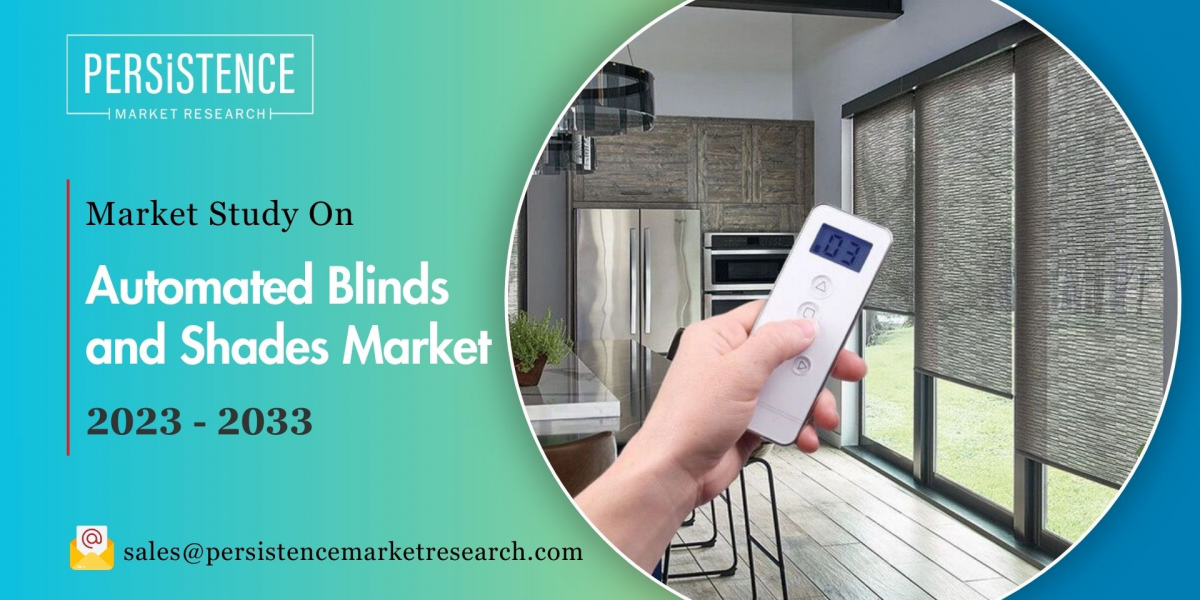The smart home industry has seen explosive growth over the past decade, with homeowners embracing new technologies to make their living spaces more comfortable, efficient, and secure. Among the most innovative features gaining traction is motorized blinds, also known as automated or smart blinds. These cutting-edge window treatments offer a blend of convenience, energy efficiency, and modern design, making them a popular choice for both residential and commercial applications.
As more people seek to integrate smart technology into their homes, the demand for motorized blinds continues to surge. This blog delves into the factors driving this demand, the key market trends, and the role of motorized blinds in the future of smart homes.
The Growing Market for Motorized Blinds
According to Persistence Market Research's projections, the global Automated Blinds and Shades market is valued at approximately US$ 4.5 billion in 2023 and is expected to grow at a compound annual growth rate (CAGR) of 9.8%, reaching US$ 11.4 billion by 2033. Key drivers include the rising adoption of smart home devices, growing urbanization, and the increasing need for energy-efficient solutions in buildings.
This growth is reflective of a broader trend within the smart home industry, as homeowners continue to seek innovative solutions that can be integrated seamlessly into their living environments. Motorized blinds, with their combination of technology, convenience, and energy-saving features, have emerged as a key component of this evolution.
What are Motorized Blinds?
Motorized blinds are window coverings that can be controlled electronically, typically through a remote control, smartphone app, or voice commands using smart home assistants like Amazon Alexa, Google Assistant, or Apple Siri. These systems can be programmed to adjust automatically based on a range of factors, such as time of day, sunlight intensity, or user preferences.
The appeal of motorized blinds lies in their ability to offer effortless control over natural lighting and indoor climate. With a simple voice command or app setting, homeowners can raise or lower their blinds, close them during peak sunlight hours to reduce heat, or open them to allow natural light to enter a room.
Key Factors Driving the Demand for Motorized Blinds
1. Rising Adoption of Smart Home Devices
The surge in popularity of smart homes has been a major catalyst for the demand for motorized blinds. With smart home technology becoming more accessible and affordable, homeowners are increasingly looking for ways to automate various aspects of their homes, from lighting and security to temperature control.
Motorized blinds have become an integral part of this smart home ecosystem, as they can be integrated with other devices to create a fully automated and energy-efficient living space. The ability to control blinds through voice commands or smartphone apps has made them a popular choice for those looking to simplify their daily routines and enhance the comfort of their homes.
For instance, motorized blinds can be programmed to close automatically when the sun is at its peak, helping to maintain a cooler indoor environment and reduce the need for air conditioning. Conversely, they can be set to open in the morning to let natural light flood into the home, reducing the reliance on artificial lighting. This level of convenience is a significant driver of demand, particularly among tech-savvy homeowners.
2. Energy Efficiency and Sustainability
With growing awareness of environmental issues and the need to reduce energy consumption, motorized blinds are increasingly being viewed as an eco-friendly solution for modern homes. They contribute to energy savings by optimizing the use of natural light and heat, thereby reducing the need for artificial lighting and HVAC systems.
In fact, one of the biggest advantages of motorized blinds is their ability to adjust automatically based on external factors such as sunlight, temperature, and time of day. For example, during the summer months, motorized blinds can be programmed to close during the hottest parts of the day, preventing excessive heat from entering the home. This reduces the strain on air conditioning systems and lowers energy bills. In the winter, they can be set to open during daylight hours to let in sunlight and naturally warm the room.
This energy-saving potential aligns with broader sustainability goals, making motorized blinds an attractive option for environmentally-conscious consumers. As more homeowners prioritize energy efficiency, the demand for motorized blinds is expected to grow.
3. Convenience and Comfort
Another key factor driving the demand for motorized blinds is the convenience and comfort they offer. With traditional blinds, adjusting window treatments throughout the day can be a manual and often cumbersome task, especially in homes with large windows or hard-to-reach areas. Motorized blinds eliminate this hassle by offering hands-free control.
Homeowners can easily control multiple blinds simultaneously, set schedules for opening and closing, or use sensors to adjust the blinds automatically based on lighting and temperature conditions. This enhanced level of control not only improves comfort but also adds an element of luxury to the home.
In homes with large windows or skylights, motorized blinds are particularly useful, as they provide an easy way to manage window coverings without the need for ladders or manual adjustments. This convenience is one of the primary reasons why motorized blinds have become a popular choice in modern homes.
Read More: https://www.persistencemarketresearch.com/market-research/automated-blinds-and-shades-market.asp
4. Aesthetic Appeal and Customization
In addition to their functional benefits, motorized blinds also offer aesthetic appeal. Available in a wide range of materials, colors, and designs, they can complement any interior style, from modern and minimalist to traditional and cozy. The clean lines and sleek operation of motorized blinds can enhance the overall look of a room, adding a sophisticated touch to the decor.
Moreover, motorized blinds can be customized to fit various window sizes and shapes, making them a versatile option for both standard and unconventional window designs. Homeowners have the freedom to choose the type of blind that best suits their style, whether it be roller blinds, Roman shades, or Venetian blinds, all of which can be motorized for seamless operation.
5. Integration with Home Automation Systems
The ability to integrate motorized blinds with existing home automation systems is another significant factor contributing to their growing demand. As more homeowners invest in smart home hubs and automation platforms, they are looking for products that can be easily integrated and controlled through a single interface.
Motorized blinds are compatible with many popular smart home systems, allowing users to create customized scenes and schedules. For example, homeowners can set up a "Good Morning" routine that automatically raises the blinds, turns on the lights, and starts the coffee maker. Similarly, a "Good Night" scene could lower the blinds, lock the doors, and adjust the thermostat.
This level of integration provides homeowners with a seamless and intuitive smart home experience, further driving the adoption of motorized blinds.
Challenges in the Motorized Blinds Market
While the market for motorized blinds is growing rapidly, it is not without its challenges. One of the primary barriers to adoption is the cost. Motorized blinds tend to be more expensive than traditional blinds, particularly when considering installation and integration with smart home systems.
Additionally, some homeowners may be hesitant to invest in motorized blinds due to concerns about complexity or the need for professional installation. While advances in technology have made these systems more user-friendly, there is still a learning curve for those unfamiliar with smart home devices.
Conclusion
The demand for motorized blinds in smart homes is set to continue growing as more homeowners recognize the benefits of automation, energy efficiency, and convenience. With the market projected to reach $11.4 billion by 2033, motorized blinds are quickly becoming a staple of modern living spaces.
As smart home technology evolves and becomes more accessible, the appeal of motorized blinds will only increase, offering homeowners a practical, stylish, and energy-efficient solution for managing natural light and enhancing their overall home experience.
Follow Us: LinkedIn | Medium | Twitter








